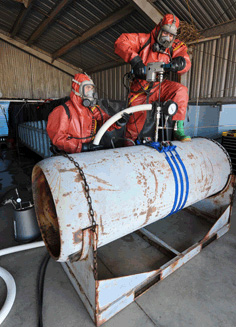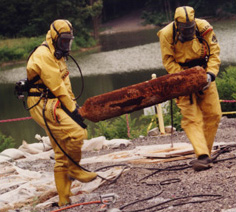Compressed Gas Cylinders
Handling waste compressed gas cylinders poses unique hazards and challenges associated with the chemical composition of each gas, the energy of compression, and the capability of a gas to move and flow freely when not contained.
Pressurization of a cylinder creates a potential hazard even for inert gases. A typical cylinder pressurized to 2000 psi contains energy equivalent to nearly one and a half pounds of TNT. Failure of the cylinder and/or valve can create an extremely dangerous projectile.
Chemical hazards associated with compressed gas cylinders differ greatly depending on the wide variety of gases that are stored in cylinders. Gases can be classified into groups each having distinctive hazards. Extremely toxic gases and liquids suddenly released from a compressed gas cylinder can rapidly reach lethal concentrations in surrounding areas. Reactives such as oxygen or fluorine are powerful oxidizers. These gases can easily cause other materials to ignite and cause explosions during uncontrolled releases. Many gases used in rocket fuels, (such as pentaborane, tetrafluorohydrazine and chlorine trifluoride) are capable of explosive reactions with little initiation. Powerful corrosives such as anhydrous hydrogen fluoride will hydrolyze to form acid when exposed to moist air. These acid gases are extremely dangerous to anyone exposed to them.
Flammable gases present fire and explosion hazards in confined spaces. Pyrophoric liquids are often non-pressurized materials stored in gas cylinders that can spontaneously ignite if exposed to air. Some unstable gases such as hydrogen cyanide and ethylene oxide are inherently hazardous due to the potential for exothermic polymerization. Gases such as hydrogen bromide can react with moisture in a way that causes the cylinder to become over-pressurized, leading to the potential for explosive, catastrophic failure.
Reactive mixtures of gases are not ordinarily stored in a single cylinder. However, extremely hazardous mixes are possible and have been encountered in operations where manifolding of different gases are employed.
Compounding the hazards associated with waste compressed gases are cylinders which are buried and whose exact locations are unknown present even greater challenges. Specialized techniques for excavation of unknown cylinders have been successfully employed and refined by IES.
All of the above hazards must be addressed to safely manage waste compressed gas cylinders. Moreover, when contents are unknown, it must be assumed that any of the above hazards may be present.

with an inoperable valve.

cylinder from pond.